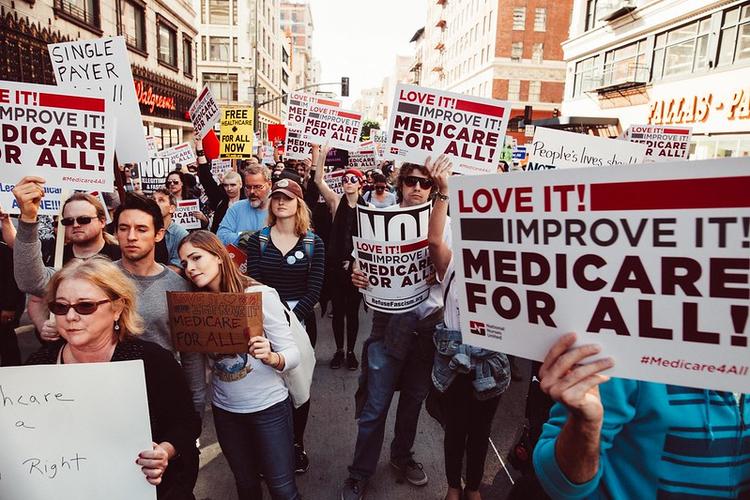Gainesville, Florida (Special to Informed Comment) — Congress enacted Medicare in July,1965, to provide health insurance for people ages 65 and older and the disabled regardless of income or medical history. In the 55 years since, Medicare has become living proof that public, universal health insurance is superior to private insurance in every way. Medicare is more efficient than private health insurance and is administered at a cost of 3 percent to 4 percent, as opposed to private, for-profit health insurance, which has administrative costs above 15 percent. In light of the burgeoning, severe losses of jobs/employment/health insurances caused by the ravages of the COVID-19 pandemic, it’s very Important to remember that Medicare is still providing stable coverage for everyone 65 and older. If the new and improved Medicare for All, as outlined below, were in place today, everyones health insurance, in spite of the COVID-19 pandemic, would continue uninterrupted because the Medicare insurance system is based on citizenship, not employment.
Medicare’s costs over 55 years have risen more slowly than those of private health insurance industry. Medicare provides better access to care, better financial protection and higher patient satisfaction. Although some have negative feelings toward government, and examples of government inefficiency and incompetence exist, the record of private health insurers is far worse. Dozens of financial profiteering scandals have wracked private insurers and HMOs in recent years.
To continue our 55 years of progress, it’s time to upgrade Medicare by establishing a 21st century “Medicare for All” health insurance system that covers all age groups, cradle to grave. Newborns will leave the hospital with their new Medicare card, and drop it off years later at life’s end. Two comprehensive M4A bills now filed in Congress, H.R. 1384 and S.1129, propose to insure/cover all medically necessary services. Patients have their choice of physicians, mental health professionals, other health care professionals, hospitals and clinics.
M4A insured health services include:
1). primary care
2). medically approved diet and nutrition services
3). inpatient care
4). outpatient care
5). emergency care
6). prescription drugs
7). long-term care and palliative care
8). mental health services
9). dentistry
10). eye care
11). substance abuse treatment
Because our government, instead of private profit health insurance companies, serves us as the health insurance financing authority, co-pays and deductibles paid at health professionals offices are ended because payment for health insurance is fully prepaid directly into Medicare, much like Social Security, and covered at first dollar amounts. This means the obsolete 80 percent/20 percent payment split between private health insurance companies and Medicare is eliminated, with Medicare for All covering 100 percent.
With M4A, citizens are guaranteed access to health care while achieving significant overall savings compared to our existing obsolete system. This is accomplished by lowering administrative and eliminating profiteering costs, controlling Big Pharma prices of prescription drugs, fees for physicians and other health-care professionals and hospitals, reducing unnecessary treatments and expanding preventive care.
Good health care would be established as a basic human right, as in almost all other advanced countries. Nobody would have to forego needed treatments because they didn’t have insurance or they couldn’t afford high insurance premiums and co-pays. Nobody would have to fear a financial disaster because they faced a health care crisis in their family. Virtually all families would end up financially better off and most businesses would also experience cost savings compared to what they pay now to cover their employees.
We finance our new and improved Medicare for All system by eliminating profiteering by the private health insurance industry and slashing the system-wide administrative waste they generate, with a single streamlined, nonprofit public payer health insurance system. Such savings, estimated in 2017 to be about $500 billion annually, would be redirected to patient care.
Existing tax revenue would fund much of the system. According to a 2016 study in the American Journal of Public Health, tax-funded expenditures already account for about two-thirds of U.S. health spending. That revenue would be retained and supplemented by modest progressive taxes based on ability to pay, taxes that would typically be fully offset by ending today’s very high premiums paid to the for-profit private insurance industry and out-of-pocket expenses for care. The vast majority of U.S. households — one study says 95 percent —would come out financially ahead. The system would reap savings by dealing with drug and medical supply companies for lower prices.
More than two dozen independent analyses of federal and state single-payer legislation by agencies such as the Congressional Budget Office, the General Accountability Office, the Lewin Group and Mathematica Policy Research Group have found that the administrative savings and other efficiencies of a single-payer program would provide more than enough resources to provide first-dollar coverage to everyone in the country with no increase in overall U.S. health spending.
M4A is a solid investment in our country because it promotes a social service for universal access to affordable health insurance for everyone. A majority of Americans support Medicare and want expansion of this program to provide health insurance for all. Write to your senators and representatives and let them know how you feel about expanding Medicare. The very best way to cope with the vast dangers of COVID-19 to everyone is to immediately implement improved Medicare for All with H.R.1384/S.1129. By making health insurance available to all age groups, we can enjoy and celebrate Medicare’s 55th birthday with the assurance that this life-saving health insurance program will continue.
Featured Photo: Flicker.



 © 2026 All Rights Reserved
© 2026 All Rights Reserved